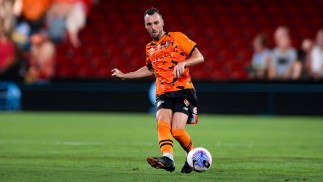Some players can score at will but how do you measure the mark of a true goal-scoring champion, is it by pure goals or perhaps goals per game?
With one week of the 2011/12 regular season remaining, Brisbane Roar-s Besart Berisha sits on 19 goals, a goal tally that is equal with the highest number of goals ever recorded in a Hyundai A-League season.
The A-League-s record tally of 19 goals for a regular season was initially set by Shane Smeltz, in 2009/10 with Gold Coast United.
Whether or not Berisha creates a new outright record of most goals in a regular A-League season (which will happen if he scores in the last round) debate will rage amongst football statisticians about how to best measure the most effective goalscoring performance over a season.
Following from the tradition set in the old National Soccer League (NSL), the Hyundai A-League Golden Boot winner is awarded to whoever scores the most goals in a Hyundai A-League regular season – that is, excluding finals.
Previous award winners were 2010/11 Sergio Van Dijk (Adelaide United, 16 goals), 2009/10 Shane Smeltz (Gold Coast United, 19 goals), 2008/09 Smeltz again (Wellington Phoenix, 12 goals), 2007/08 Joel Griffiths (Newcastle Jets, 12 goals) and 2006/07 Danny Allsopp (Melbourne Victory, 11 goals).
(No offense, but I-m thinking the 2005/06 Golden Boot award should be rescinded, after the leading scorers – and there were four of them – could only manage a measly 8 goals each!)
The first potential flaw a statistician will point to when discussing leading goalscorer for a season is the aspect that finals series matches don-t count in determining the Australian Golden Boot winner.
How is it that Archie Thompson wasn-t the Golden Boot winner in 2006/07 even though he scored more goals over the season (15) than 2006/07 Golden Boot winner Danny Allsopp (13).
(By the way, the answer is that Thompson scored just 10 goals in the regular season and Allsopp 11 – Thompson-s 5 goals in the 2006/07 Grand Final just don-t count!)
This stat is one that argues that goals scored in finals series matches should be included in determining the Golden Boot winner. My simple argument is that finals matches are part of a season.
There are a few other factors that statisticians like to consider when determining the most effective goalscorer over a season.
Average goals per game is one such alternative performance measure – recognising players who have a high scoring ratio but whose club appearances over a season may be limited due to factors such as injury, or being selected in a national team.
Another factor often overlooked is the ratio of goals scored by a player to the total number of goals scored by that player-s team in that season. For example, a player who scored 10 goals for a team who scored just 20 over the season (50 per cent of team goals) could be considered more effective than a player who scored 15 goals for a team who scored 60 goals over a season (25 per cent of teams goals).
So let-s check out the winners and some other high place-getters in each of these categories over the 34 completed Australian national league seasons since the NSL started in 1977.
Most goals in a regular season (Golden Boot): 31, by Damian Mori for Adelaide City in 1995/96. The next highest regular season goal tallies are 23 by John Kosmina (Sydney City 1982), 22 by Mori (Adelaide City 1999/2000), and then 21 goals by Gary Cole (Heidelberg 1980) and David Zdrilic (Sydney United 1996/97).
Most goals in a complete season (including finals):31, by Damian Mori for Adelaide City in 1995/96. Mori also scored the second-highest (24 goals for Perth Glory in 2002/03) and equal fourth-highest (22 goals for Adelaide City in 1999/2000) number of goals in a complete national league season. Kosmina-s 23 goals in 1982 slots him into third-highest over a complete season.
Highest goals per game ratio in a season: 1.00. But this is a tricky one, because even though there are a number of players who achieved this seemingly-impressive feat of scoring an average of one goal per game over a season, most of these were scored where the player made only one, or just a few games that season.
Nevertheless it-s still worth mentioning a few players who achieved the 1.00 goals per game ratio in an Australian season, if only because there are some amazing names there.
English legend Sir Bobby Charlton (Blacktown City 1985), and John Samaras (South Melbourne 1988) – a little-known Australian-born striker who made it big time in the Greek national team and first division – each scored one goal in one solitary guest appearance over the season.
Arsenal and Newcastle United hero Malcolm McDonald (3 games for South Melbourne in 1977), Yugoslav idol Zdravko Borovnica (2 games for Footscray in 1977) and Aussie big-timer Craig Johnston (4 games for Newcastle KB in 1982) are other noteworthy names who scored a goal a game in short guest stints.
Of the 24 players who achieved a goal-a-game ratio over a national league season, particular credit should go to Zlatko Nastevski (11 games for Marconi in 1989/90) and Ante Milicic (11 games for Sydney Olympic in 2001/02), who achieved the goal-a-game ratio in a significant number of games for the season.
If we only consider players who played at least 20 matches over the season, the highest goals per game ratio in an Australian national league campaign is shared by Charlie Egan (South Melbourne 1985) and Mark Viduka (Melbourne Knights 1994/95), who both scored 21 goals in 24 matches over these seasons, an impressive ratio of 0.88 goals per game each.
Highest ratio of team-s goals scored by an individual in a season: 0.52, by Shane Smeltz for Wellington Phoenix in 2008/09 – this figure is derived by dividing the number of goals scored by Smeltz in 2008/09 (12) by the total number of Wellington Phoenix goals that season (21).
The next highest ratio of team goals scored in a season was 0.488 by Charlie Egan for South Melbourne in 1985 – Egan scored his 21 goals in 1985 in a team who scored just 43 goals over the season. Coming in third highest is Smeltz again (0.487), who scored 19 goals for a Gold Coast team that scored 39 goals in 2009/10.
So while Brisbane-s brilliant Berisha barnstorms his way to the top of the 2011/12 A-League scorer-s table, it-s a good time to reflect on the goalscoring feats of some of the talents of previous years. There have been many other great goalscorers that have graced our grounds.
Follow Andrew Howe-s Aussie football stats updates on Twitter @AndyHowe_statto



